PDF Version
February 2009
Christine Carrington
Small Business Branch, Industry Canada
Summary:
Small and medium-sized enterprises (SMEs) account for the majority of businesses in Canada and drive job creation, productivity and growth in the economy. Access to sufficient and appropriate financing is a critical element for SMEs to succeed in the marketplace. The Canada Small Business Financing Act (CSBFA), created in 1999, is a partnership between the Government of Canada and financial institutions to extend the supply of credit to small businesses. The Canada Small Business Financing (CSBF) program aims to help new businesses establish themselves and expand, improve access to loans that would otherwise be unavailable to small firms and, thereby, stimulate economic growth in Canada.
Using data from Statistics Canada, this profile provides an overview of the characteristics of borrowers under the CSBF program and compares financing activity between CSBF program borrowers and the Canadian SME population.
Summary of key findings:
During the 2004–2005 period, a total of 11 112 loans were extended under the CSBF program worth $1 billion.Footnote 1 The majority of CSBF program loans (64 percent) were made to small businesses in Ontario and Quebec. CSBF program borrowers were typically found to operate younger businesses (many still in the start-up stage) in Canada's service industries. Furthermore, SMEs under the CSBF program had a higher growth orientation and were more likely to be involved in research and development (R&D) activities. In terms of financing, CSBF program borrowers had significantly higher capital needs than other Canadian SMEs and, likely due to their participation in the CSBF program, were more likely to have their financing applications approved in 2004. At the same time, CSBF program borrowers faced more stringent credit application requirements than other SME borrowers in terms of documents requested and collateral required as security. Aside from formal credit instruments, CSBF program borrowers were also more likely to draw on informal sources of financing, such as personal savings, credit instruments of the business owner or trade credit from suppliers.
Definitions
Small and medium-sized enterprises (SMEs) are defined as commercial (for-profit) businesses with fewer than 500 employees and less than $50 million in annual revenues. Excluded are non-profit and government organizations, schools, hospitals, subsidiaries, co-operatives, and finance and leasing companies.
This analysis compares the profile and financing activity of SMEs that received financing under the Canada Small Business Financing Act, either in 2004 or previously, with those of the Canadian SME population.
Overview of the Canada Small Business Financing Program
The Canada Small Business Financing Act (CSBFA) was created in 1999 as the successor to the Small Business Loans Act (SBLA), which had assisted small businesses in obtaining debt financing since 1961. The CSBF program seeks to increase the availability of loans for establishing, expanding, modernizing and improving small businesses.
Under the program, a small business must apply for a loan at a financial institution (bank, credit union or Caisses populaires). There is currently a network of about 1285 private-sector lenders that are able to participate in the program, with about 14 600 points of service across Canada. Lenders are responsible for all credit decisions, making the loans, providing loan funds and registering the loans with Industry Canada. Lenders are also responsible for the administration of loans. The Government of Canada pays lenders 85 percent of any eligible losses incurred on defaulted loans, with lenders being responsible for the remaining 15 percent.
Canada Small Business Financing Program parameters
- Borrower eligibility
- Firms with annual sales of $5 million or less are eligible to use the program. Farming and charitable or religious organizations are excluded.
- Loss-sharing ratio
- The government shares in eligible losses after realizations on security. Its share of eligible losses for loans in default is 85 percent. Lenders are responsible for the remaining 15 percent.
- Assets financed
- Loans are restricted to financing the following: (1) purchase of leasehold improvements, equipment, software and real property or immovables; (2) improvement to equipment and real property; and (3) program registration fees.
- Percentage of asset cost financed
- The maximum amount of financing available is 90 percent of the cost of the assets.
- Maximum financing amount
- A borrower cannot have more than $250 000 in total loans outstanding under the CSBF program.
Between 1999 and 2004, the CSBF program facilitated nearly $5.4 billion in debt financing through approximately 66 000 loans. The average loan size throughout this period was $82 000 (see Figure 1),Footnote 2 and the average loan term was 68.5 months.
Figure 1
Number and Value of CSBF Program Loans and Claims, 1999–2004
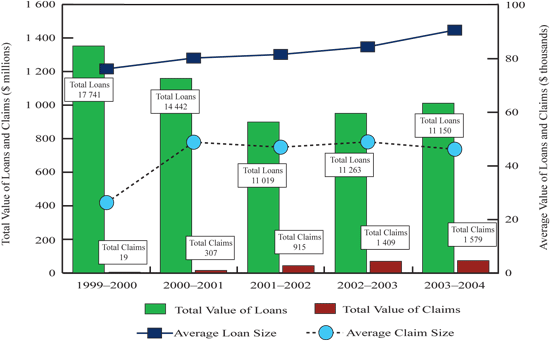
Source: Industry Canada, Canada Small Business Financing Program, Comprehensive Review Report, 1999–2004, 2004.
During the 2004–2005 period,Footnote 3 a total of 11 112 loans were extended under the CSBF program worth $1 billion.Footnote 4 CSBF program loans were made to small businesses in every province and territory. While the majority of CSBF program borrowers were located in Canada's largest provinces, Quebec (36 percent) and Ontario (28 percent), the proportions were not consistent with their shares of the overall SME population. There was significantly higher CSBFA lending occurring in Quebec per business during 2004–2005 than in Ontario (see Figure 2).
Figure 2
Distribution of CSBF Program Borrowers versus the SME Population across Canada, 2004–2005
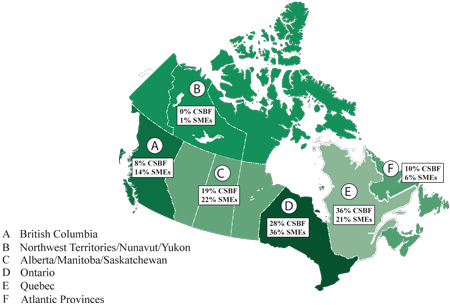
Source: Statistics Canada, Survey on Financing of Small and Medium Enterprises, 2004; Industry Canada, Canada Small Business Financing Program, Comprehensive Review Report, 2004–2005, 2005.
The CSBF program also had a strong presence throughout Canada's rural areas despite its exclusion of lending to farming enterprises. Approximately one third of CSBF program borrowers were located in rural areas in 2005.Footnote 5 This is higher than the proportion of SMEs located in rural areas in 2004 (19 percent, excluding farming).
Profile
CSBF program borrowers typically younger businesses
According to Statistics Canada's 2004 Survey on Financing of Small and Medium Enterprises, slightly over half of SMEs using the CSBF program (51 percent) were young firms that reportedly began selling products or services within the past five years (i.e. between 1999 and 2004). Thirty-six percent of these CSBF program borrowers were start-up companies that entered the market between 2002 and 2004. This is significantly different from the overall age distribution of SMEs that are not using the program, where only 30 percent began operations in the five years prior to 2004, 11 percent of those being considered start-ups. However, these findings are consistent with the objectives of the CSBF program to facilitate financing for growth and expansion of smaller firms. In fact, the latest comprehensive review of the program revealed that "start-up firms younger than one-year old accounted for 50 percent of the five-year [1999‑2004] total number of CSBF loans."Footnote 6 This report provides a more accurate picture of the CSBF program because it includes all borrowers.
Table 1 presents additional characteristics of entrepreneurs using the CSBF program. Overall, CSBF program borrowers tended to be younger and have fewer years of management experience than other SMEs. Notably, a significantly higher percentage of CSBF program borrowers were also French-speaking (43 percent versus 19 percent of all SMEs). This is consistent, however, with the higher than average usage of the CSBF program within the Province of Quebec. It is also worth noting that most CSBF program borrowers and SMEs (75 percent in each case) started their businesses from scratch.
| Characteristics | CSBF Program Borrowers | All SMEs | |
|---|---|---|---|
| Source: Statistics Canada, Survey on Financing of Small and Medium Enterprises, 2004. | |||
| Gender | Wholly or majority owned by men | 68% | 63% |
| Majority owned by women or equal male/female partnerships | 32% | 37% | |
| Age | Between 30 and 39 years | 26% | 15% |
| Between 40 and 49 years | 43% | 35% | |
| Between 50 and 64 years | 21% | 37% | |
| First Language | Speak English | 48% | 67% |
| Speak French | 43% | 19% | |
| Speak a non-official language | 9% | 14% | |
| Managerial Experience | Have fewer than 5 years | 22% | 12% |
| Have 5 to 10 years | 20% | 19% | |
| Have more than 10 years | 58% | 69% | |
| Business Acquisition | Started their business from scratch | 75% | 75% |
| Acquired it from a non-family member | 16% | 13% | |
| Acquired it from a family member | 7% | 9% | |
Majority of CSBF program borrowers are smaller firms
As illustrated in Figure 3, nearly three quarters of small business borrowers under the CSBF program had fewer than five employees in 2004–2005. This is somewhat different from the overall size structure of all Canadian SMEs, in which over 80 percent of SMEs employed fewer than five employees in 2004. This suggests that CSBF program borrowers are experiencing higher employment growth in their firms than the overall SME population despite their propensity to operate in service sectors (see the following section). This supports a Statistics Canada economic impact study of the CSBF program that found higher employment growth among CSBF program borrowers than similar SMEs that were not program borrowers.Footnote 7 In fact, it has been reported that CSBF program loans have created approximately 2.9 jobs per loan, for an estimated 223 846 net jobs created between 1999 and 2005.Footnote 8
Figure 3
Distribution of CSBF Program Borrowers by Size of Business, 2004-2005

Source: Industry Canada, Canada Small Business Financing Program, Comprehensive Review Report, 2004–2005, 2005.
Sectoral distribution of CSBF program borrowers
Borrowers under the CSBF program largely operate in Canada's service industries. As illustrated in Figure 4, four in five CSBF program loans are made to service-sector-based firms. Of these, 20 percent of program loans (27 percent by value) were made to SMEs in accommodation and food services, 16 percent (by number and value) to retail or wholesale firms and 14 percent (10 percent by value) to transportation and warehousing enterprises.
Figure 4
Distribution of CSBF Program Loans by Industry Sector, 2004-2005
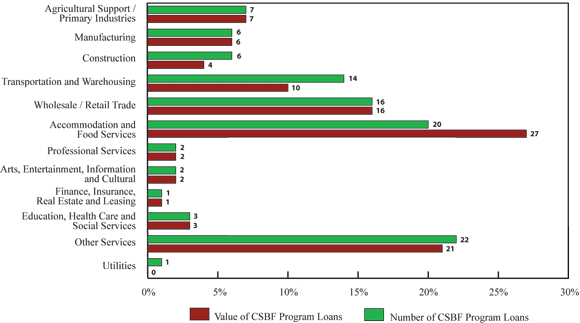
Source: Industry Canada, Canada Small Business Financing Program, Comprehensive Review Report, 2004-2005, 2005.
Conversely, only 6 percent of loans (by number and value) went to CSBF program borrowers that operated in the manufacturing sector. The large proportion of CSBF program loans being extended to SMEs in service industries is filling a void as past research has shown that smaller businesses in service sectors have more difficulty in accessing financing than those in the manufacturing or resource-based sectors.Footnote 9
Financial performance of CSBF program borrowers
Table 2 presents select financial statement data for the average CSBF program borrower in comparison with two other categories of SMEs: the average non-borrowing SME and the average borrowing SME. While a number of estimates could not be reported for data quality concerns, available data do indicate significantly higher sales activity occurring among SMEs under the CSBF program in comparison with the average non-borrowing SME. In 2004, CSBF program borrowers brought in, on average, 36 percent higher sales revenue and nearly 33 percent higher total revenues than the average non-borrowing SME. This supports findings from a Statistics Canada economic impact study of the CSBF program that found that CSBF program borrowers had 43 percent higher sales growth over a four-year period than similar SMEs that were not program borrowers.Footnote 10
| Average CSBF Program Borrower | Average Non-Borrowing SME | Average Borrowing SME | |||
|---|---|---|---|---|---|
| Request Granted | Request Refused | ||||
| (average $) | |||||
| Note * of Table 2: Figures do not add up due to rounding and the absence of some income statement or balance sheet data. Source: Statistics Canada, Survey on Financing of Small and Medium Enterprises, 2004. | |||||
| Revenues | Sales of Goods and Services | 775 304 | 568 591 | 938 430 | 678 517 |
| Total Revenues | 821 603 | 618 436 | 1 007 688 | 700 303 | |
| Assets | Current Assets | — | 199 193 | 311 166 | 196 114 |
| Total Assets | 490 783 | 523 048 | 898 030 | 470 586 | |
| Liabilities | Current Liabilities | — | 120 902 | 256 515 | 146 923 |
| Total Liabilities | 367 547 | 277 534 | 577 874 | 304 101 | |
| Equity | Retained Earnings | — | 135 577 | 126 926 | 56 118 |
| Total Equity | 123 236 | 245 514 | 320 156 | 166 485 | |
A comparison of financial statements of the average CSBF program borrower with the average SME that borrowed in 2004, but not under the program, shows that the latter has higher revenues and a stronger balance sheet. The average borrowing SME has close to 23 percent higher total revenue and 160 percent more equity compared with the average CSBF program borrower. These facts lead to two observations. First, SMEs that have borrowed have a higher level of business activity as reflected by higher sales levels. Second, among those borrowers, the CSBF program captures those that have a weaker balance sheet, which is consistent with the objective of the program to improve access to financing for smaller firms. CSBF program borrowers are nevertheless in a relatively good financial position in comparison with the average SME that sought financing but was refused. The average CSBF program borrower has 17 percent higher revenues than the average SME borrower that saw its request turned down. As 75 percent of CSBF program borrowers are businesses that would not have received financing under market conditions,Footnote 11 the fact that they have a stronger financial position than SMEs that did not qualify for a loan suggests that the CSBF program is effective in selecting the stronger of the SMEs facing difficulties in accessing credit.
Growth obstacles faced by CSBF program borrowers
Achieving growth targets can be a challenge for all SMEs. For CSBF program borrowers, the obstacles are often significantly higher. By definition, businesses under the CSBF program are growing or expanding their operations and face difficulty in accessing sufficient levels of capital from financial institutions to accomplish their objectives. Indeed, 62 percent of CSBF program borrowers were planning to expand within the next two years compared with only 39 percent of all SMEs. Furthermore, 34 percent of CSBF program borrowers reported expenditures on research and development (R&D) in 2004 compared with 28 percent of all SMEs.
Given the appetite for growth and innovation among CSBF program borrowers, it is not surprising that significantly higher percentages of these firms are reporting barriers to growth than other Canadian SMEs. As shown in Table 3, over half of CSBF program borrowers report taxation levels and a lack of skilled labour in Canada as obstacles to achieving their growth targets. Government regulations were also cited as a barrier by a substantial proportion of businesses under the CSBF program (41 percent versus 33 percent of SMEs). While access to financing was cited relatively less frequently as a barrier to growth than most other factors, it was still reported by more than one in three CSBF program borrowers compared with one in five SMEs not using the CSBF program.
| CSBF Program Borrowers | SMEs | ||
|---|---|---|---|
| % | |||
| Source: Statistics Canada, Survey on Financing of Small and Medium Enterprises, 2004. | |||
| External to the Firm | Levels of Taxation | 54 | 47 |
| Finding Qualified Labour | 54 | 37 | |
| Instability of Consumer Demand | 35 | 36 | |
| Government Regulations | 41 | 33 | |
| Internal to the Firm | Insurance Rates | 44 | 36 |
| Low Profitability | 39 | 38 | |
| Obtaining Financing | 37 | 20 | |
| Management Capacity | — | 13 | |
Financing activity
A central tenet of the CSBF program is incrementality, which occurs when loans made under the program would not have been made at all, or would have been made under less favourable terms, in the absence of the program. Research undertaken for the 2004 comprehensive review of the CSBF program found that 50 percent of CSBF program loans were made under circumstances in which the borrower would not qualify for any other loan at all. An additional 27 percent of program loans allowed small businesses to obtain larger loans than would otherwise have been approved.Footnote 12
The following section examines the financing activity of CSBF program borrowers in 2004 in comparison with other Canadian SMEs, illustrating the role the program plays in facilitating much-needed financing for these small businesses.
Capital needs among CSBF program borrowers
In 2004, 70 percent of CSBF program borrowers reported seeking some form of external capital compared with 24 percent of SMEs not using the program. The vast majority of these requests were for debt financing. Moreover, 60 percent of CSBF program borrowers made an application for commercial loans or credit in 2004 compared with 18 percent of SMEs (see Table 4). While these differences may appear drastic, it is important to note that, by definition, the CSBF program borrowers surveyed had applied for and received a CSBF program loan within the past 12 months. The majority of other Canadian SMEs that did not seek financing in 2004 reported that it was because they did not need financing at that time.
| Type of Financing | CSBF Program Borrowers | SMEs | |
|---|---|---|---|
| % | |||
| Note * of Table 4: Data not available due to low quality or confidentiality concerns. Source: Statistics Canada, Survey on Financing of Small and Medium Enterprises, 2004. | |||
| Debt Financing | Request Rate | 60 | 18 |
| Approval Rate | 92 | 81 | |
| Lease Financing | Request Rate | 16 | 3 |
| Approval Rate | 99 | 96 | |
| Government Grant or Subsidy | Request Rate | n/a Note * referrer of Table 4 | 3 |
| Approval Rate | 82 | 70 | |
Just over half of CSBF program borrowers that sought debt financing in 2004 approached a chartered bank (57 percent) and 37 percent applied to a credit union or Caisses populaires compared with 63 percent and 23 percent of other SMEs respectively. The higher likelihood of approaching credit unions or Caisses populaires is consistent with the higher percentage of CSBF program borrowers located in rural areas and in Quebec, where these financial institutions hold significantly higher market shares than elsewhere in Canada.
Financing approval rates were also higher among CSBF program borrowers in 2004 than other SME borrowers. Ninety-two percent of CSBF program borrowers that applied for debt in 2004 were approved by their financial provider compared with 81 percent of other SME borrowers. It is to be expected that CSBF program borrowers would receive higher approval rates, particularly for debt financing, as, by definition, CSBF program borrowers received program loans, although they may have been rejected for other financing requests.
The average size of loans obtained by CSBF program borrowers in 2004 was $119 000, which was slightly smaller than the average loan obtained by other SME borrowers ($146 000). The majority of credit applications from CSBF program borrowers in 2004 (75 percent) were intended to finance the purchase of fixed assets. The majority of applications from other SMEs were for working capital (56 percent). This is consistent with the parameters of the CSBF program as an asset-based lending program and not as a program for financing the operating needs of the business.
Stringent application process for CSBF program borrowers
Figure 5 presents the collateral and documentation requirements for loans made to CSBF program borrowers in 2004 compared with other SMEs. In all respects, CSBF program borrowers faced more stringent requirements in their credit applications than other business owners. A higher percentage of CSBF program borrowers were required to pledge business assets as security compared with other SMEs. As well, higher percentages of CSBF program borrowers had to provide formal applications, financial statements, and particularly business plans to their financial providers. The collateral, formal application and appraisal procedures exercised by financial institutions with respect to CSBF program borrowers are consistent with the requirements of the CSBF program.
Figure 5
Security and Documentation Required by Financial Providers, 2004
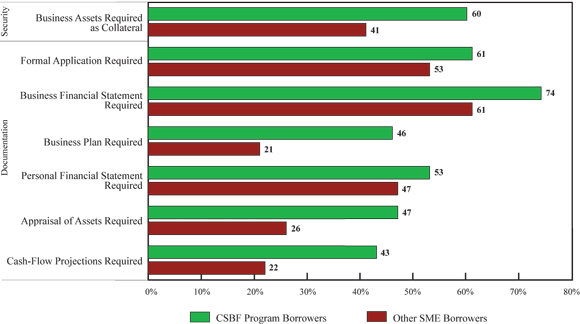
Source: Statistics Canada, Survey on Financing of Small and Medium Enterprises, 2004.
Satisfaction with financial providers
The CSBFA is administered by Canada's chartered banks, credit unions and Caisses populaires. In 2004, 55 percent of CSBF program borrowers dealt with chartered banks and 45 percent went to credit unions or Caisses populaires. CSBF program borrowers reported dealing with their main financial services providers for an average of 6.7 years. This is slightly lower than the 11-year average that SMEs had dealt with their main financial services providers. This difference may be partially explained by the fact that CSBF program borrowers have typically been in business for a shorter period of time than the average SME.
Although CSBF program borrowers had typically dealt with their main financial services providers for less time than other SME borrowers, CSBF program borrowers reported higher levels of satisfaction with their financial services providers in 2004. As shown in Figure 6, sixty-one percent of CSBF program borrowers were reportedly satisfied with the overall quality of service they received from their financial services providers compared with 57 percent of SMEs. Higher percentages of CSBF program borrowers were also more satisfied with the convenience and accessibility of their financial services provider and their relationship with their account manager. The latter is likely a result of the fact that 74 percent of CSBF program borrowers had a designated account manager in 2004 compared with 48 percent of SMEs that were not part of the CSBF program.
Figure 6
Level of Satisfaction among CSBF Program Borrowers with Their Main Financial Services Provider, 2004 Note * referrer of Figure 6
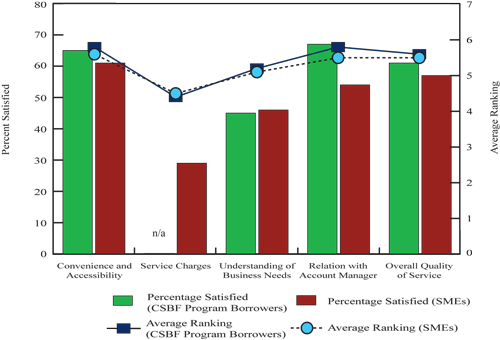
Note * of Figure 6: Level of satisfaction is measured on a seven-point scale where one is "very dissatisfied" and seven is "very satisfied."
Source: Statistics Canada, Survey on Financing of Small and Medium Enterprises, 2004.
Capital structure
SME borrowers typically draw on a diversified portfolio of financing instruments to meet their business' capital requirements. The same is true for borrowers under the CSBF program, particularly as their businesses are often younger and more growth oriented. CSBF program borrowers have higher usage rates of all sources of financing (for both start-up and ongoing operations) than other SMEs.
Figure 7 presents the main sources of financing used by current CSBF program borrowers when they started up their businesses compared with other SME borrowers. Before the first sale of goods or services, small businesses that used the CSBF program also used formal (e.g. commercial loans, lines of credit and leasing) and informal (e.g. personal savings and credit instruments) sources of financing at a far greater rate than other SME borrowers. This is particularly true in their usage of commercial loans and lines of credit, with 90 percent of CSBF program borrowers obtaining commercial loans and 71 percent using commercial lines of credit to establish their business compared with 45 percent and 44 percent of other SME borrowers respectively. The high incidence of CSBF program borrowers using commercial loans to establish their businesses, and the finding that 50 percent of CSBF program loans went to start-up firms less than one-year old between 1999 and 2004,Footnote 13 suggest that many CSBF program borrowers use the loans to help establish their businesses.
Figure 7
Sources of Financing Used During Start-up Note * referrer of Figure 7

Note * of Figure 7: Start-up is defined as the period prior to the first sale of goods or services. Sources of financing include any source used, regardless of whether it was authorized or obtained in a previous year.
Source: Statistics Canada, Survey on Financing of Small and Medium Enterprises, 2004.
CSBF program borrowers also used all sources of financing to a greater extent during ongoing operations of their businesses than other SMEs. Figure 8 presents the financing instruments that CSBF program borrowers used in 2004 in comparison with other Canadian SMEs. Commercial loans and lines of credit were the main sources of financing for CSBF program borrowers, as would be expected among small businesses that are under the program. However, CSBF program borrowers appear to augment this financing with a wide mix of other formal and informal financing instruments.
Figure 8
Sources of Financing for Established Firms, 2004 Note * referrer of Figure 8
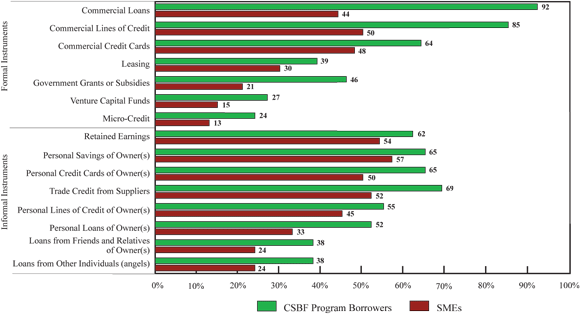
Note * of Figure 8: Includes any source used, regardless of whether it was authorized or obtained in a previous year.
Source: Statistics Canada, Survey on Financing of Small and Medium Enterprises, 2004.
Summary and discussion
The Canada Small Business Financing program plays an important role in ensuring Canadian SMEs have the necessary financing to grow and succeed in the marketplace. This study found that the majority of CSBF program loans (64 percent) were made to small businesses in Ontario and Quebec. CSBF program borrowers were typically found to operate younger businesses (many still in the start-up stage) in Canada's service industries. Furthermore, SMEs under the CSBF program had a higher growth orientation and were more likely to be involved in research and development activities than other Canadian SMEs in general. In terms of financing, CSBF program borrowers had significantly higher capital needs than other Canadian SMEs and, likely due to their participation in the loan guarantee program, were more likely to have their financing applications approved in 2004. At the same time, CSBF program borrowers faced more stringent credit application requirements than other SME borrowers in terms of documents requested and collateral required as security. Aside from formal credit instruments, CSBF program borrowers were also more likely to draw on informal sources of financing, such as personal savings, credit instruments of the business owner or trade credit from suppliers.
Under provisions of the Canada Small Business Financing Act, a comprehensive review of the program is conducted every five years. Findings included in this profile of CSBF program borrowers will assist in the in-depth research and analysis that will be undertaken for the next review, covering the period from April 2004 to March 2009. Visit the CSBFP website for additional information and to access research and reports.
References
- Equinox Management Consultants, Incrementality of CSBF Program Lending. Volume 3. Findings from Survey Data, 2004. A report prepared for the Canada Small Business Financing Act Comprehensive Review, 1999–2004.
- Industry Canada, Canada Small Business Financing Program, Comprehensive Review Report, 1999–2004, 2004.
- Industry Canada, Canada Small Business Financing Program, Comprehensive Review Report, 2004–2005, 2005.
- Industry Canada, Canada Small Business Financing Act: Comprehensive Review Report 1999–2004, April 2005.
- Industry Canada, Canada Small Business Financing Act: Annual Report 2004–2005, 2006.
- Small Business Economics, Incrementality of SME Loan Guarantees, 2007.
- SME Financing Data Initiative, Industry Canada, Small and Medium-Sized Enterprise Financing in Canada, 2003.
- Statistics Canada, Survey on Financing of Small and Medium Enterprises, 2004.
- Statistics Canada, Longitudinal Economic Impact Study of the Canada Small Business Financing (CSBF) Program, 2005. A report prepared for the Canada Small Business Financing Act: Comprehensive Review, 1999–2004, April 2005.
Financing Profiles is an ongoing series of articles on specific segments of the marketplace and a component of Industry Canada's reporting efforts on SME financing.
Statistics Canada administers a series of national surveys on small and medium-sized enterprises (Survey on Financing of Small and Medium Enterprises) and financial providers (Survey of Suppliers of Business Financing). Industry Canada supplements these surveys with additional research into niche areas of SME financing.
For further information regarding the methodology of the Survey on Financing of Small and Medium Enterprises, visit Statistics Canada's website at www.statcan.ca.
For further information on this profile, email SBB-DGPE.
